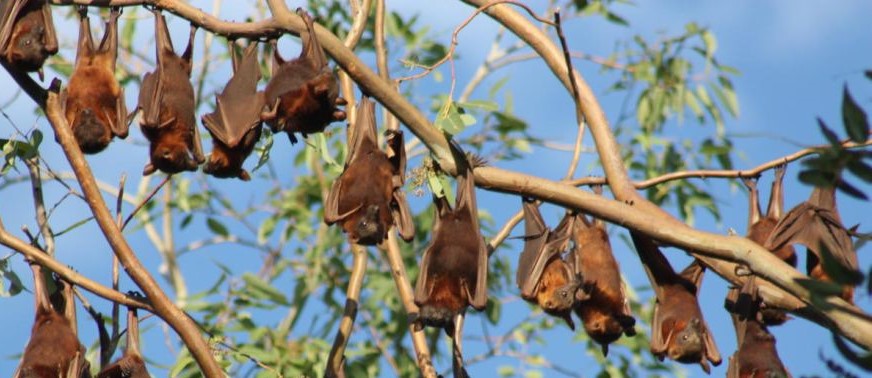Bats (Flying Foxes)
Flying Fox Information

Photo: ABC
Mount Isa is home to a seasonal little red flying-fox roost, particularly in spring and summer following rainfall. Little red flying-foxes (Pteropus scapulatus) are native wildlife protected under legislation. They are a nomadic species, travelling around Australia following the blossoming of native trees.
Flying-foxes gather during the day in ‘roosts’, generally in dense vegetation near water and foraging resources. The size of a roost fluctuates in response to local food availability. Flying-foxes often develop a strong affinity with certain roosts, returning year after year. Just like you, they think the Mount Isa region is a great place to visit and hang out!
Threats to flying-foxes include habitat loss, culling at orchards, entanglement in barbed wire, power line electrocution and cyclones, drought and heatwaves. Flying-foxes breed slowly, having only one pup per year, which limits their ability to respond to these threats.
The flying forest farmer
Flying-foxes are like farmers for our forests; pollinating flowers and dispersing the seeds of many native trees including eucalypts, bloodwoods and angophoras. Some of these rely on nocturnal pollination from bats more than daytime pollinators such as bees. Flying-foxes can also travel up to 100 kilometres in a single night, compared to about a kilometre for insects, which means they can have a greater impact on the long-term health and biodiversity of our native forests. These forests in turn give us fresh air, places to recreate, timber, medicinal resources as well as acting as carbon sinks.
Foraging flying foxes
Flying-foxes forage for food between dusk and dawn. Little red flying-foxes feed almost exclusively on nectar. Flying-foxes are attracted to urban areas because our parks and gardens provide a wide variety of food all year round. Human activities also reduce their habitat in other areas. Flying-foxes will only visit your garden at night while trees are flowering or fruiting.
A day in the life…
Little red flying-foxes tend to roost in tight groups; the weight of these can break branches. Trees will usually recover when the little reds leave town during the cooler months, but don’t stand underneath roost trees just in case!
During the day, flying-foxes spend their time grooming, sleeping and chatting – they are highly intelligent and very social animals with a complex language.
Flying-foxes are also very clean animals; grooming themselves with their claws, thumb and tongue. The smell associated with a roost is actually just their natural scent. Male flying-foxes have scent glands on their shoulders which they rub along branches to mark their territory. Mothers and pups also communicate using scent.
Tips for living near flying foxes
Flying-foxes may seem like a nuisance to some people and are often misunderstood. Issues relating to smell, noise, mess and damage to vegetation are usually short-lived and can generally be quickly addressed.
Droppings can be removed by hosing with water, and you can limit the number foraging around your yard by managing plants that attract them - those with edible fruits or flowers with lots of nectar. Bagging fruit or removing it before it ripens on fruit trees, or netting trees. Make sure netting is pulled taught and the weave is too small to fit your finger through, this will stop wildlife getting entangled.
Flying-foxes may take off suddenly if frightened, dropping out of a tree before they can gain height, but they do not swoop or attack humans - they would rather avoid us! There is no need to be afraid of flying-foxes flying overhead or feeding in garden trees.
Human and animal health
Although a small percentage of bats may carry viruses, such as Australian Bat Lyssavirus and Hendra virus, the occurrence and transmission are very rare and public health risk is low.
Less than 1% of flying-foxes are affected by Lyssavirus, which has only been spread to people or pets through a bite or scratch from an infected bat. Effective post-exposure vaccinations are available if this does happen.
Hendra virus can only be transferred to humans through close contact with an infected horse; it cannot be transferred directly from bat to human. Unvaccinated horses can be infected by ingesting contaminated food or water, and so infection can be prevented through appropriate husbandry.
You cannot contract these viruses by spending time near a roost, if flying-foxes fly overhead, or if they feed or roost in your garden.
If you find a sick, injured or orphaned flying fox
If you find a sick, injured or orphaned flying fox, do not attempt to help it yourself. Contact RSPCA (1300 ANIMAL) or the Department of Environment and Science (1300 130 372).
If you have been bitten or scratched, wash the wound with soap and water and seek medical attention as soon as possible from your doctor or Queensland Health. Also remember to keep your pets away from foraging or roosting bats, and contact your veterinarian if your pet has been bitten or scratched.
Flying Foxes and the Environment - Factsheet(PDF, 615KB)